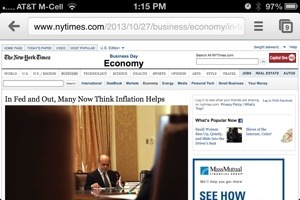Economists at the St. Louis Fed periodically estimate the probability of a U.S. recession. The econometric model that they use incorporates monthly data on non-farm payroll employment, industrial production, personal income, manufacturing sales, and trade sales. The model was fairly successful at predicting the most recent recession in 2008. See graph below.

U.S. Recession Probabilities
http://research.stlouisfed.org/fred2/series/RECPROUSM156N?cid=33120
2013-07: 1.34 Percent
| 2013-06: |
0.66 |
|
| 2013-05: |
0.36 |
|
| 2013-04: |
0.58 |
|
| 2013-03: |
0.44 |
|
Monthly, Not Seasonally Adjusted, Updated: 2013-10-01 8:11 AM CDT
Details:
Smoothed recession probabilities for the United States are obtained from a dynamic-factor markov-switching model applied to four monthly coincident variables: non-farm payroll employment, the index of industrial production, real personal income excluding transfer payments, and real manufacturing and trade sales. This model was originally developed in Chauvet, M., “An Economic Characterization of Business Cycle Dynamics with Factor Structure and Regime Switching,” International Economic Review, 1998, 39, 969-996. (http://faculty.ucr.edu/~chauvet/ier.pdf)
For additional details, including an analysis of the performance of this model for dating business cycles in real time, see:
Chauvet, M. and J. Piger, “A Comparison of the Real-Time Performance of Business Cycle Dating Methods,” Journal of Business and Economic Statistics, 2008, 26, 42-49.
(http://pages.uoregon.edu/jpiger/cp_realtime_2_020907.pdf)
For additional details as to why this data revises, see FAQ 3 athttp://pages.uoregon.edu/jpiger/us_recession_probs.htm.

